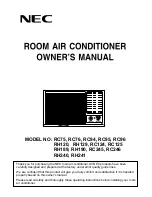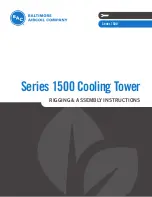
Installation manual
13
REYQ8~16M8W1B
VRVII System air conditioner
4PW23712-1
■
Only proceed with wiring work after blocking off all power.
■
Always ground wires. (In accordance with national regulations of
the pertinent country.)
■
Do not connect the ground wire to gas pipes, sewage pipes,
lightning rods, or telephone ground wires.
•
Combustion gas pipes: can explode or catch fire if there is a gas
leak.
•
Sewage pipes: no grounding effect is possible if hard plastic
piping is used.
•
Telephone ground wires and lightning rods: dangerous when
struck by lightning due to abnormal rise in electrical potential in
the grounding.
■
This unit uses an inverter, and therefore generates noise, which
will have to be reduced to avoid interfering with other devices.
The outer casing of the product may take on an electrical charge
due to leaked electrical current, which will have to be discharged
with the grounding.
■
Be sure to install an earth leak detector. (One that can handle
higher harmonics.)
(This unit uses an inverter, which means that an earth leak
detector capable of handling high harmonics needs to be used
in order to prevent malfunctioning of the earth leak detector
itself.)
■
Earth leak detector which are especially for protecting ground-
faults should be used in conjunction with main switch or fuse for
use with wiring.
■
This unit has a negative phase protection circuit. (If it operates,
only operate the unit after correcting the wiring.)
7.4.
Examples
System example
(See figure 18)
Field line connection
L1, L2, L3, N-phase of the power cord should be clamped to the
plastic bracket using field supplied clamp material.
The green and yellow striped wrapped wires should be used for
grounding.
(See figure 14)
(See figure 20)
1
Field power supply
2
Main switch
3
Earth leak detector
4
Fuse
5
Cool/heat selector
6
Remote controller
7
Outdoor unit
8
BS unit
9
Indoor unit
Power supply wiring (sheathed cable)
Transmission wiring (sheathed cable)
1
Power supply (400 V, Three-phase)
2
Fuse
3
Grounding wire
4
Earth leak detector
5
Attach insulation sleeves
6
Power supply terminal block
7
Ground wire
8
Clamp the ground wires along with the power wires using field supplied
clamps.
9
Clamp each power wire separately to the plastic bracket using field
supplied clamps.
10
When wiring, do not allow the ground wires to contact the compressor
lead wires. If the wires contact each other, adverse effects may occur
to other units.
11
When connecting two wires to one terminal, ensure that the crimp-style
terminals face with each other back to back.
Moreover, make sure that the wire of the smaller gauge is located
above.
12
Crimp-style terminal
13
Wire gauge: Small
14
Wire gauge: Large
15
Plastic bracket
1
Electric wiring
2
Wiring between units
3
Clamp to the electric box with field supplied clamps.
4
When routing out the power/ground wires from the right side:
5
When routing the remote control cord and inter-unit wiring, secure
clearance of 50 mm or more from the power wiring. Ensure that the
power wiring does not contact any heated sections (
).
6
Clamp to the back of the column support with field supplied clamps.
7
When routing out the inter-unit wirings from the opening for piping:
8
When routing out the power/ground wires from the front:
9
When routing out the ground wires from the left side:
10
Grounding wire
11
When wiring, pay attention not to detach the acoustic insulators from
the compressor.
12
Power supply
13
Fuse
14
Earth leakage breaker
15
Ground wire
16
Unit A
17
Unit B
18
Unit C









































